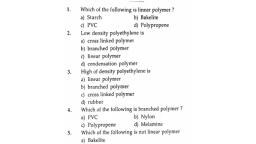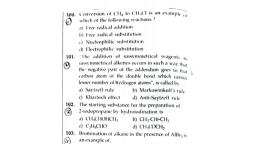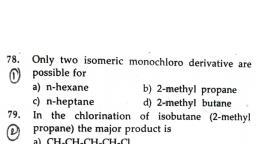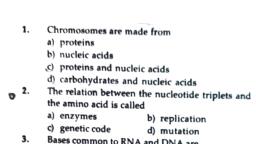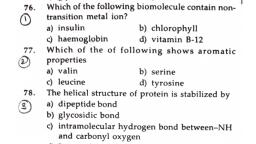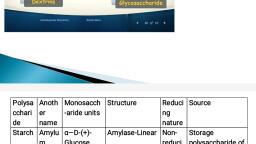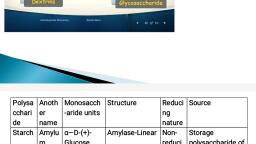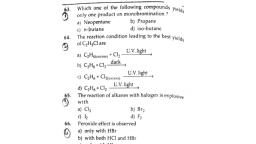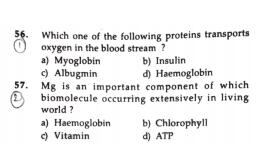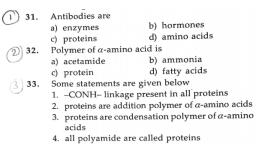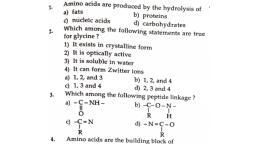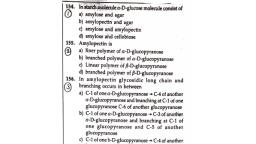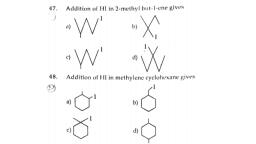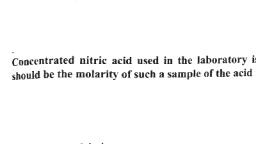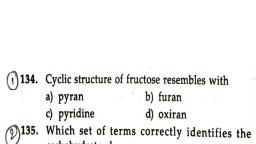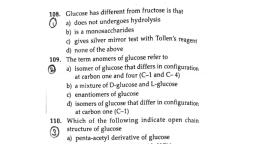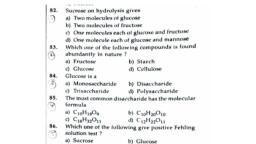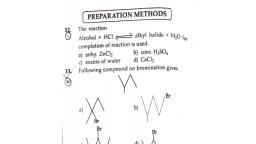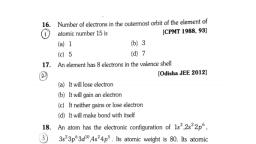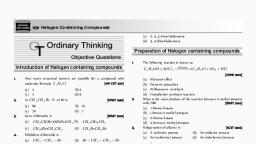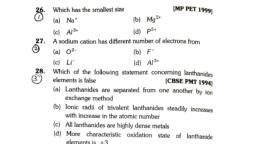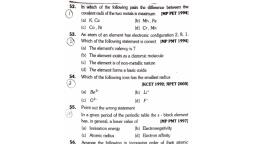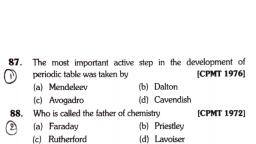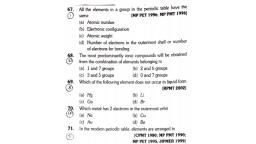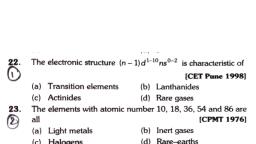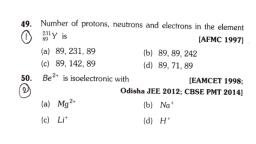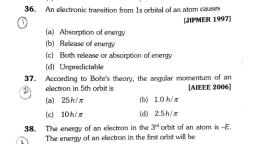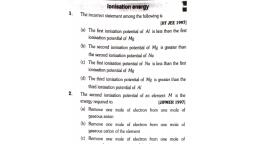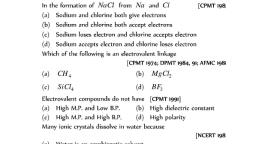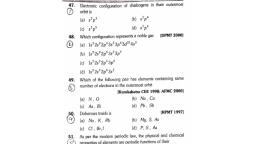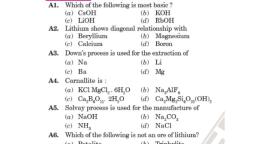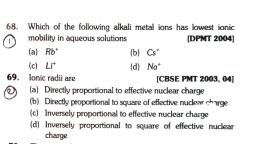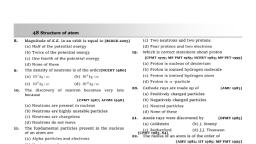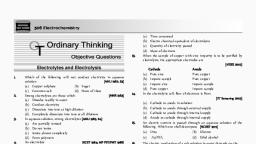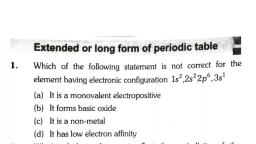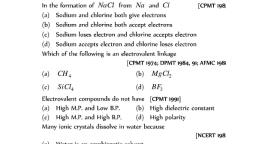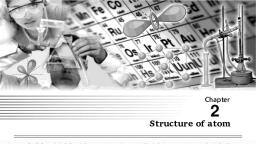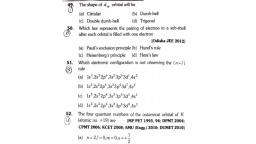Page 1 :
ll., , 12., , Atomic and tonic t, , The ionic radii (A) of C* and O* respectively are 2.60, and 1.40. The ionic radius of the isoelectronic ion N*, , would be [BHU 2006), (a) 2.6 {b) 1.71, {c) 14 {d) 0.95, ‘The smallest among the following ions is [JIPMER 1999), (a) Na* (b) Mg", {c) Ba® (d) Al’, Which is smallest in size (RPMT 1997], fa) 07 (bo) ch, (c) F {d) N>, Which of the following has largest size, , (MP PMT 1995, 2003; JIPMER (Med.) 2002), (a) Al fb) Al”, (c} Al? (a) are, , Of the following, the one with largest size is, (EAMCET 1997; BHU 1999], , (a) Cl (b} Ar, (c} K* (d) Ca®*, Which one of the following is the biggest ion [MP PET 1993], (a) ate (b) Ba**, () Mg" {d) Na’, The radii of F,F~,O and O® are in the order of, [AIMS 1999; CPMT 1999}, , (a) O* >F >O>F {bo} O? >F- >F>0, , (c} F >O0® >F>0 (d) O* >0>F° >F, Which of the following has the smallest size, , (CBSE PMT 1996; MP PMT 2013), fa) No’ (b} Mg”, , {c) CI {d) Fo, , Which of the following is largest [CBSE PMT 1996}, (a) cr (b) S*, , (cl Now (d) Fo, , Which of the following property displays progressive, increase down a group in the Bohr's periodic table, , (a) Blectronegativity (b) Blectron affinity, {c) lonisation potential (d) Size of the atom, Atomic radii of fluorine and neon in angstrom units are, , respectively given by {UT JEE 1987}, (a) 0.762, 1,60 fb) 1.60, 1.60, , (c) 0.72, 0.72 id} None of these values, Which ion has greatest radius in the following [CPMT 1976}, (a) H tb) F, , (c) Br {d) !
Page 2 :
13., , 14,, , 15., , 16., , 17., , 18., , 19,, , 21., , Se ~— 2., Which has the maximum atomic radius, , [AIMS 1982; DPMT 1982], (a) Al (b) Si, (c) P (d) Mg, Which one of the following ions has the highest value of, ionic radius [EAMCET 1993; MP PET 2001, 11; AIEEE 2004), la) OF (b) B, (ce) Lit (d) F, On going down a main sub-group in the periodic table, {example Li to Cs in IA or Be to Ra in IIA), the, expected trend of changes in atomic radius is @, [CPMT 1981), (a) Continuous increase, (b} Continuous decrease, (c)_ Periodic one, an increase followed by a decrease, (d) A decrease followed by increase, , Which one of the following is the smallest in size, [IIT JEE 1989}, , fa) N* {b) 07, , (c) F (d) Na”, Which one is the correct order of the size of the iodine, species [Pb. CET 1986; CBSE PMT 1997;, , Kurukshetra CEE 1998; RPMT 1999; DCE 1999, 2007;, MP PET 2000; MP PMT 2001;, , BCEE 2005; NCERT Exemplar}, fa) T>I* or tb) P> I >r, fc) IP >> >t (d} Po >for, Which one has larger radius (CPMT 1997; KCET 2005), (a) Not (ol F, «| F (d) Na, In third row of periodic table the atomic radii from Na to Cl, (MP PMT 1986), (a) Continuosly decreases, (b) Continuosly increases, (c) Remains constant, (d)_ Increases but not continuously, The size of the following species increases in the order, {IIT JEE 1990; AFMC 1995; DCE 2006), , fa) Mg® <Na't <F- <Al, , {b} F< Al<.Na* > Mg”, , (c) Al<Mg®" <F° <Na*, , (d) Na* <Al<F> <Mg*, , In K*F~ ionic radius of F is more while atomic radius of, K' is [CPMT 1997), (a) Less than F~ (b) More than F~, , (c) Equal of F {d) None of these, , The set representing the correct order of ionic radius is, [AIEEE 2009), , (a) Li’ > Be®* > Na” > Mg”, {b) Nat >Li7 > Mg” > Be*’, (c) Lit > Na” > Mg** > Be**, (d) Mg?* > Be®* > Li” > Na”
Page 3 :
23,, , 24., , 25., , , , The ionic radii of N*, 0%, F~ and Na’ follow the, order [MP PMT 1996, 2000; MP PET/PMT 1998], , (a) N* >0* >F> >Na*, (b) N*> >Na*>0” >F, (c) Nat >O* >N* >F, (d) 0% >F> >Na* >N*, , On moving down a group of regular elements, both atomic, and ionic radii increases with increasing [Bihar MEE 1995], , (a) Atomic number (b) Atomic weight, (c) Atomic mass (d) None of these, Which one of the following indicates the correct order of, atomic size (EAMCET 1989], , (a) Be>F>C>Ne (b) Be< C<F<Ne, (c) Be>C>F>Ne (d) F<Ne<Be<C
